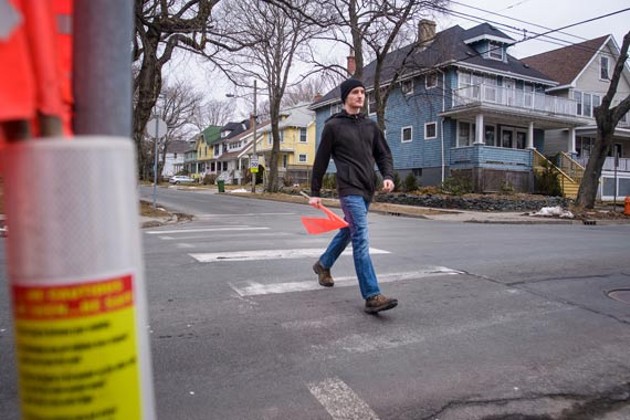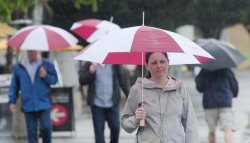
From Halifax Nova Scotia, The Globe and Mail reports on the “Crosswalk Safety Society” that are placing “high-visibility flags” on crosswalks where there are no crossing lights and no safety features. While staff at the Halifax Regional Municipality urged Council to get rid of these flags and create safer pedestrian crossings, council voted to continue with the flags being available at those crosswalks. And these flags are not inexpensive, with the Crosswalk Safety Society shelling out $250 to outfit each crosswalk with them.
Only 2 to 6 percent of pedestrians use these flags to wave at cars when they are crossing, and when a reporter watched an intersection for two hours, pedestrians did not use the flags at all.
The concept of intersection flags have been tested in Berkeley California and in Seattle and were dismissed as being ineffective and giving pedestrians a fake sense of confidence. It also puts the onus on the pedestrian for getting the driver’s attention and stopping a vehicle, something that should be the responsibility of the driver. For small children, using flags is one more thing to take attention away from the important task of simply safely crossing the road.
Kudos to municipal staff in Halifax that conducted their own tests at two intersections, crossing each of them three hundred times. “They found that drivers gave way 94 per cent of the time when flags were being carried and 89 per cent of the time at crossings where there were no flags. Driver compliance was lowest, at 86 per cent, when flags were present but not carried”.
No matter what the political reasons are for allowing a group to place flags on crosswalks, that does not address the issue of making the street safer for pedestrians to cross. CityLab explored flags and crosswalks four years ago and concluded that asking people to carry a flag when crossing a street does not put the pedestrian first. Fort Lauderdale tried this as “a multipronged effort to improve drivers’ awareness of laws that require them to stop at marked crosswalks”.
What does it take to change driver behaviour at crosswalks? CityLab reports that an observational study by Active Transportation Alliance showed that only 18 percent of drivers stopped for pedestrians at marked crosswalks. Flashing lights and raised or textured crosswalks raised the stopping rate to 61 per cent. This study was done in Chicago where Illinois law requires vehicles to stop for pedestrians crossing the road.
Why do drivers not stop at crosswalks? CityLab suggests that it is not only the way streets are designed to encourage traffic flow, but also that people “don’t walk very much themselves. They don’t project themselves in the pedestrian’s frame of mind when they’re driving, because they are rarely in the pedestrian’s position at any other time.”
That response suggests that as sustainable cities encouraging aging in place and supporting active transportation that more education, enforcement of driver behaviour and speed, and better street crossing design is needed to keep the most vulnerable road users-pedestrians~safe and walking.
Unbelievably the City of Cupertino California has a video showing how flags are to be used while crossing a street on the way to school.No surprise that the “thumbs up and down” buttons and comments have been disabled on this video.

